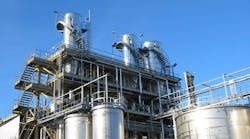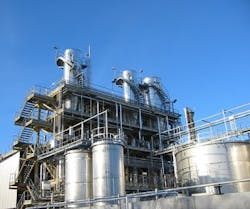Agile manufacturing is all about achieving rapid changeover between different products with minimum disruption to the process involved. Increasingly, particularly for batch operations, this relies on real-time information.
"Batch production must take into account varying raw material properties and potencies to ensure a quality end product. Access to this sort of information in real-time is very important. Batch systems need to take advantage of this information to dynamically adjust operating quantities. Also, standard batch products need to adjust to variances in ingredient delivery and adjust all remaining feeds to stay within specification without requiring custom engineering," explains Andrew Stump, batch, information and advanced process control segment manager, process systems team, Rockwell Automation, Mayfield Heights, Ohio.
The growing trend of utilizing real-time production data crucially depends on collecting such data within the context of production activities, notes Stump. Two approaches dominate. In the first, real-time batch reporting summarizes production details and process trend data for on-demand review — generally via a fixed format report for a defined purpose. In the second, tools, such as Gantt chart view of activity tied to process conditions at that moment, allow real-time analysis of batch execution — enabling users to shift time horizons, correlate process trend data and look at different parts of batch activity and their impact on production.
"By collecting this data, it enables users to leverage historical event and trend data for real-time golden batch analysis with real-time monitoring software to identify variation in the model," he adds.
However, one size doesn't fit all, Stump says. "There is a need for local standalone skid-based batch control. These systems should offer the flexibility to fit into larger process trains without re-engineering."
Figure 1. Sweden's Perstorp will be one of the first European users of the latest version of DeltaV.
Source: Emerson Process Management.
An automation upgrade project carried out at the Axis, Ala., plant of Philadelphia-based Arkema, Inc., shows the importance of collecting real-time data. To create impact modifiers for polymers, Arkema's engineers use a batch reactor to produce a liquid latex material that then goes into a spray dryer as part of a continuous process. Each batch takes about 12.5 hours to complete. The plant annually makes about 85 million pounds of 15 different impact modifiers.
Arkema was suffering increasing problems with its legacy distributed control system. (Half the plant used a 28-year-old version and the other half a 15-year-old one.) It was struggling to find both the people and equipment to make necessary repairs. At the same time, a simple recipe change could shut down the plant for ten hours — while failure episodes were costing $42,000 every month.
"More importantly, safety concerns were starting to crop up. The plant experienced a few potentially critical incidents stemming from aging I/O [input/output] hardware and control systems that were overburdened. As the current system lacked condition-monitoring capabilities, plant personnel were not alerted to problems until it was too late," notes John Bryant, engineering and maintenance manager.
The site upgraded to PlantPAx from Rockwell. This system helps meet long-term control system needs and minimizes production risks. Its FactoryTalk Batch recipe management software ensures batch quality and helps reduce manual adjustments while adhering to S88-compliancy.
The plant has achieved yearly savings of more than $500,000, a 50% reduction in batch programming time, better batch consistency, and improved safety though enhanced data monitoring. Moreover, switchover between production campaigns now incurs minimal downtime.
With the new system, a production engineer can modify procedures and load recipes at the same time while keeping everything synched. It has spurred improved consistency in both the control recipe and procedure. Arkema can constantly try new grades and immediately make changes to a batch.
Rockwell's latest offering is a local controller-based solution, the Logix batch and sequencing manager, which is part of its PlantPAx process automation system. On limited release for over a year, it reportedly already has proven itself in the chemical industry as a reliable way to solve the challenge of moving from simple R&D tabletop processes to full-scale production without re-engineering.
"The challenge in the chemical industry is that generally a scientist does the R&D in the lab. Feedback from this group is that servers, software and mainstream batch production systems are not optimal," says Stump. "Logix batch and sequence manager overcomes this by offering the scientist a simple HMI [human/machine interface] based view to configure product definitions, control batch execution and capture data for analysis. This same system then can scale up to full production when the time is right. In fact one of the world's top chemical companies is doing this today." That company's lab and pilot plant reactors rely on Logix batch and sequence manager to prove out a process prior to moving to commercial-scale production.
Rockwell emphasizes the need for scalability. The PlantPAx system allows the code that works on single reactors to be integrated into existing mainstream FactoryTalk Batch based solutions for large-scale multi-vessel systems. The latest release of FactoryTalk Batch software includes many new enhancements requested by customers, including: intelligent recipe features, improved run-time user control, expanded data collection and reporting, and better material management capability.
"Overall we are looking for quicker time to value. That means much tighter integration with the process real-time batch reporting and as much standard out-of-the-box functionality as possible," Stump stresses.
Complex Challenges
Batch processors face multiple challenges. Consider, for instance, a project that PVC Compounders of Kendallville, Ind., a producer of pellets for injection molding and extrusion, has just undertaken at its satellite plant in El Paso, Texas.
Because all pellets made at the El Paso plant are compounded to order, the plant stocks minimal inventory. Instead it gets daily deliveries of fillers and other raw materials. Operators must have immediate access to formulations so they can ensure the right ingredients for a particular product — including plasticizers, stabilizers, fillers and lubricants — go from the silos to the mixing line. After mixing, operators manage the cooling process and monitor the finished powder as it moves to the pellet extruder.
Scheduling of batches and confirming of formulas take place in the plant control room. The inventory control and scheduling systems connect with the parent facility in Indiana.
Besides ensuring consistent and accurate recipes, the plant must carefully control the manufacturing environment. Temperatures in El Paso can range from 40°F in winter to 120°F in summer — these extreme temperature fluctuations can't be allowed to affect the final product. In addition, because many operators are non-native English speakers, facilitating clear communications also is a priority.
To meet its needs, PVC Compounders selected a custom software solution from Wonderware, a unit of Invensys Operations Management, Plano, Texas. The Wonderware System Platform links El Paso to the main plant in Indiana, providing a unified environment for visualization of the plant floor, plant history, device communications and automation application integration. It also works with the plant's programmable logic controllers to form a smart system for continuous improvement. Wonderware's InTouch introduces point-and-click control to the process, including silos, storage bins and different ways of incorporating plasticizers, fillers and other ingredients. At the same time, Wonderware Historian gives operators the accurate real-time data needed to make adjustments to temperatures in the mixing process, the amperage of the mixing equipment and other parameters, ensuring that the finished product is consistent.
Before the new software was installed, operators had to consult multiple stations for scheduling, retrieving formulas and determining how many batches were required to complete an order. Now, all equipment operations can be viewed in a central location via an easy-to-interpret graphical representation of the line that avoids misinterpretation due to language.
"Wonderware has really helped us because it allows us to automate our process and reduces human interference. And that actually reduces our margin of error, making our process and product more consistent," says Subburaman Ananthanarayanan, quality manager. The plant has improved product consistency, achieved its goal of reduced scrap, and reported a lower incidence of human error. "With Wonderware in place, our internal failures have really reduced. Our goal for internal failures is less than 1%, and we've been meeting these goals," he notes.
"I would say that the Wonderware software has given us a 15–20% reduction in our downtime. We used to publish that we have an industry lead time of two weeks. But we're turning product around in our plant in less than one week on every order. I attribute that to the Wonderware software," adds Jason Gitt, general manager.
Cutting Costs
The rapid changeovers demanded by agile manufacturing shouldn't disrupt software and validation or pose production issues. "Such a changeover should be done with a focus on throughput and efficiency, operator effectiveness and asset utilization, and delivered using a robust platform that allows users to easily keep current with technology. At the same time, it should be done in a manner that will reduce maintenance, quality and regulatory compliance costs," notes Dawn Marruchella, DeltaV batch product marketing manager, Emerson Process Management, Austin, Texas.
Customer requests for more agile manufacturing techniques spurred Emerson's development of the Dynamic Unit Allocation feature in the latest release of DeltaV batch software. It aims to allow companies to respond quickly to their own production needs and market changes — while controlling costs and quality.
A second key feature in the batch software is the capability for an operator to change manufacturing equipment at any time during a batch. This permits users to recover from upset situations where the planned production equipment becomes unavailable.
A new recipe resynchronization capability enables engineers to update a recipe even after a batch has started — process improvements can be incorporated without having to wait for the next batch. This can offer substantial benefits for processes with long batch times.
The scalability of this solution appealed to Elekeiroz of Várzea Paulista, Brazil, which chose DeltaV to update its critical batch applications.
The first part of the project involved deploying DeltaV on the company's complex polyester resins process against a tight schedule. "The high point of the installation for the resin unit is the reliability of the formulas. Since the resin unit works with a very large variety of products, each formula varies from one to the other. The reliability we added to the operation is essential. It's the most important aspect of the installation," says Maria da Conceição Pinto, executive manager. In addition, the digital system's embedded historian provides documentation for ISO 9001 compliance.
Next the system was installed on the plant's plastic coatings process. Gains included more consistent batches and better product quality in a process that had been largely manual, notes Eduardo Loschi, production manager. More responsive control of process times, temperatures, pressures — in general, all the process parameters — resulted in increased production volume, more uniform quality and greater operational security.
Continuous processes also benefited from the upgrade. For example, the DeltaV system helped decrease variability, improving both productivity and process reliability at the site's maleic anhydride plant. Its embedded diagnostics contributed to an about 10% drop in ongoing maintenance costs. "Today I am able to start up, stop and operate the maleic anhydride plant totally from the control room. This is a great labor-saving advantage," notes Carlos Alberto Samartini, production manager. Production volume at the phthalic anhydride unit rose by 5% while operational labor requirements fell by 30%.
"Overall," says production engineer Miriam Coretti S Liba, "the new system has made things easier. It decreased the processing time, and there was greater process security. From what we've seen so far, we have gained in productivity and reliability."
In late August, Emerson announced that specialty chemicals group Perstorp of Perstorp, Sweden, had selected DeltaV for a control system upgrade at its pentaerythritol (penta) plant (Figure 1). The company is striving to run longer batches and reduce downtime. The Perstorp migration project will be one of Europe's first installations of version 11 of Emerson's DeltaV system.
The Security Angle
A broader general challenge to batch processors is security. While use of off-the-shelf technology has brought interoperability, efficiency and other great benefits, it also has created an ongoing security challenge, cautions Daren Moffatt, Invensys Operations Management technical consultant. (For more on security, see CP's Chemical Security Action Blog.)
In the past, the primary focus of process security has been on controlling and managing access to recipes, operations and process changes. "But today… batch access control should be integrated with managed enterprise security programs that mitigate potential threats from terrorists, hackers, malicious codes and other sources that are becoming more prevalent," he stresses. "Batch processes might be most vulnerable in the controls zone, but increasingly [are] subject to threats at the plant network and data center zones."
A "defense in depth" strategy (see "Protect Your Plant"), as well as host-based firewalls, hardening of workstations, anti-virus programs and vulnerability management, can help mitigate security threats. "While taking these appropriate mitigation measures will improve security, ongoing security management is needed for it to remain effective," Moffatt cautions.
"An effective, ongoing vulnerability management process is the foundation of a good batch process security plan. Newly discovered vulnerabilities need to be assessed in a timely fashion, and a course of action determined based on likelihood and impact. The greatest threat to your operations today comes from doing nothing. By taking steps first to assess and address, then to understand and manage security, batch processors can mitigate security risks and maintain safe, reliable and compliant operations," he adds.
Seán Ottewell is Chemical Processing's Editor at Large. You can e-mail him at [email protected].



